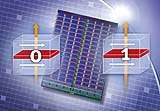New Computer Revolution is Around the Corner - the World's First 16-Mbit Magnetic RAM Prototype

Munich, Germany – June 22, 2004 – Computers that don’t loose their data, even when the power supply fails; laptops with batteries that supply power for days without the need for recharging; handheld computers and cell phones with huge amounts of memory; and personal computers that, at the touch of a button, pick up again at the exact spot where you left off the day before - In just a few years, this vision of the future of computing could become reality.
The prerequisites for it are offered by new types of memory technologies that are intensive in research like the MRAM technology. At the prestigious VLSI Circuits Symposia in Hawaii, the German semiconductor manufacturer Infineon together with IBM have presented the most advanced prototype of this revolutionary computer memory made to date: The world’s first 16-Mbit Magneto-resistive RAM (MRAM) prototype.
Unlike conventional computer chips, MRAM chips use magnetization to store information, instead of electrical charges. Up until now, computers had to continuously supply the main memory chips with power in order to store data. The information on MRAM memories, however, remains intact even after the system has been powered down. The working concept is similar to the way that data is stored on a computer’s hard disk drive. In addition, they are very fast, which enables exceptionally rapid access to data. For comparison: Infineon’s 16-Mbit MRAM chip is approximately 1,000 times faster than the non-volatile flash memory used in USB sticks, handheld computers and digital cameras. Furthermore, information can be stored in an MRAM memory cell up to one million times more often than is possible with flash memory.
The high storage capacity of the 16Mbit Chip (16 million single cells) was enabled using a small 1.4 square microns cell. By comparison 5,000 storage cells would fit on a cross section of a human hair.
“The announcement of the world’s first 16-megabit MRAM memory prototype,” emphasized Dr. Wilhelm Beinvogl, Chief Technology Officer for the Memory Products Business Group at Infineon Technologies, “is a significant breakthrough in the development of this new technology.”
In light of its many advantages, MRAM has in today’s sight the potential to enter many memory applications in a few years.
Infineon has been developing the MRAM chips in cooperation with IBM since the year 2000. The technology has been transferred recently to Altis, a joint venture of the two companies located in France.
Users would profit from the elimination of the annoying boot-up phase during which current computers load data from the hard disk drive to main memory. Additional advantages would be greater convenience, since the computer retains the current state of work, and, above all, longer battery run-times in mobile devices - from laptops to cell phones -, since non-volatility enables MRAM chips to consume less power than conventional DRAM does. In the long term, MRAM chips could also change computer architecture, which - since the early days of fast computers - has been characterized by the division of labor between the fast but volatile main memory and the slower but more permanent bulk memory.
The original press release can be found here.
















